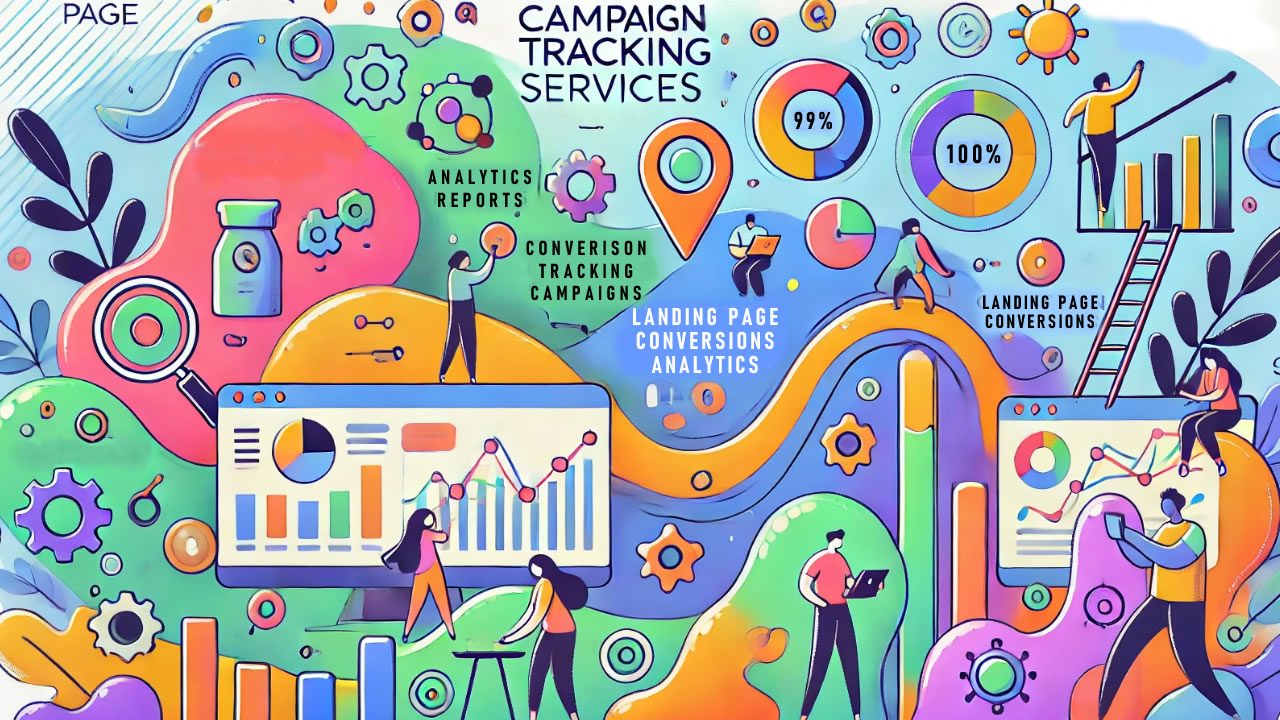Launching an ad campaign is a significant step for any business looking to increase visibility, generate leads, and drive sales. However, before you start sending traffic to your website through paid ads, it’s crucial to make sure that your website is fully prepared to convert that traffic. Whether you’re running ad campaigns on Google, Facebook, Instagram, or another platform, the success of your campaign depends on how well your website is optimized to handle and convert the traffic you send to it.
In this blog post, we’ll walk you through the essential things you should do to your website before launching an ad campaign. From optimizing for performance and user experience to setting up proper tracking, these preparations will ensure that your advertising budget is spent efficiently and delivers the best possible return on investment (ROI). We’ll also touch on platform-specific considerations and provide statistics to help you plan for tracking and measuring success. In the end, we’ll explain how our team can assist you in building, optimizing, and managing both your website and your ad campaign.
How To Prepare Your Website Before Launching Your Ad Campaign
Before you invest in paid advertising, it’s important to ensure that your website is ready to handle the increase in traffic and that it’s designed to guide visitors toward conversion. If your website is slow, hard to navigate, or poorly optimized, your ad spend will be wasted, as visitors will quickly leave without taking any action.
Here’s why preparing your website is crucial:
- Maximizing Conversion Rates: Ads bring visitors, but if your website isn’t optimized to convert them into leads or customers, you’re wasting money.
- Improving User Experience (UX): A smooth, user-friendly website keeps visitors engaged, reduces bounce rates, and encourages them to explore further.
- Tracking and Analytics: Without proper tracking, you can’t measure the success of your ads or make data-driven adjustments to improve performance.
- Alignment with Advertising Platforms: Different platforms (Google Ads, Facebook, Instagram) have unique requirements and best practices that affect how users interact with your website. Preparing your site for the specific platform you’re using is critical.

1. Optimize Website Speed and Performance
Website speed is one of the most important factors when it comes to user experience and SEO. Studies show that 53% of mobile users will leave a page if it takes longer than 3 seconds to load. In addition, search engines like Google prioritize faster websites, meaning that page speed can directly affect your SEO rankings.
What to Do
Minimize Image Sizes: Large, unoptimized images can slow down your site. Compress and resize images using tools like TinyPNG or JPEG-Optimizer to reduce load times.
Use Browser Caching: Enable browser caching to store some website files locally in the user’s browser. This will reduce the need to load the entire page each time someone visits.
Optimize CSS and JavaScript: Minify and combine CSS and JavaScript files to reduce the number of requests your server has to process. This improves load times.
Use a Content Delivery Network (CDN): A CDN distributes your website files across multiple servers globally, allowing visitors to access your site from the nearest server, thus reducing latency.
Optimize for Mobile: With mobile traffic accounting for over 50% of web traffic globally, it’s crucial to ensure that your website is fully responsive and fast on mobile devices.
Statistics to Consider:
A 1-second delay in page load time can lead to a 7% drop in conversions.
Websites with a load time under 2 seconds experience significantly higher engagement and conversion rates.
2. Ensure Clear and Engaging Calls-to-Action (CTAs)
Your website should have clear and compelling calls-to-action (CTAs) that guide visitors toward taking a specific action—whether it’s filling out a contact form, signing up for a newsletter, or making a purchase. Without effective CTAs, visitors may leave your site without engaging further.
What to Do
Create Attention-Grabbing CTAs: Use contrasting colors, large buttons, and bold text to make your CTAs stand out.
Place CTAs Strategically: Position your CTAs in prominent locations such as the top of your homepage, within product pages, and near blog content.
Align with User Intent: Tailor your CTAs to match the purpose of each page. For example, a product landing page might have a “Buy Now” button, while a blog post might feature a “Sign Up for Our Newsletter” CTA.
Statistics to Consider:
Optimized CTAs can boost conversion rates by as much as 202%.
Businesses that use CTAs effectively can generate two to five times more conversions.
3. Set Up Conversion Tracking
To ensure the success of your ad campaign, you need to have proper tracking in place to measure performance. Without tracking, you won’t know how your ads are performing, which can lead to wasted ad spend and missed opportunities for optimization.
What to Do
Install Google Analytics: Set up Google Analytics to track key metrics like page views, session duration, bounce rate, and conversions. This tool gives you insights into how users interact with your website and where they drop off.
Set Up Goals in Google Analytics: Define goals that align with your business objectives, such as completing a purchase, submitting a form, or signing up for a newsletter. This allows you to track specific actions that indicate conversions.
Add Conversion Pixels for Ads: For Google Ads, Facebook Ads, and other platforms, you’ll need to install conversion pixels or tracking tags. These pixels allow you to track user actions, such as purchases or sign-ups, and attribute them back to your ads.
Google Ads Pixel: Tracks conversions like purchases, form submissions, or phone calls that result from your Google Ads.
Facebook Pixel: Tracks conversions and allows for retargeting campaigns, so you can show ads to users who have already visited your site.
LinkedIn Insight Tag: Helps you track and retarget professional visitors from LinkedIn.
Statistics to Consider:
44% of businesses fail to track their marketing campaigns effectively, leading to missed insights and opportunities for optimization.
Proper tracking can improve your ROI by 30-50% by allowing you to optimize underperforming campaigns.

4. Ensure Mobile Optimization
With mobile users making up a large portion of internet traffic, it’s essential that your website is fully optimized for mobile devices. Mobile optimization goes beyond simply ensuring your site looks good on mobile—it’s about ensuring that it’s easy to navigate, fast, and provides a seamless user experience.
What to Do
Responsive Design: Make sure your website is responsive, meaning it automatically adjusts to fit any screen size, whether it’s a smartphone, tablet, or desktop.
Touch-Friendly Navigation: Ensure that buttons, menus, and forms are easy to tap on a mobile screen. Avoid using elements that require pinching or zooming.
Reduce Mobile Load Time: Use AMP (Accelerated Mobile Pages) where applicable, optimize images for mobile, and minimize large files to ensure your website loads quickly on mobile devices.
Test Mobile Usability: Use Google’s Mobile-Friendly Test tool to see how your website performs on mobile devices and get suggestions for improvements.
Statistics to Consider:
79% of users are more likely to revisit and/or share a mobile-friendly site.
Google uses mobile-first indexing, meaning the mobile version of your site is the primary version Google will use to rank your website.
5. Create Landing Pages Tailored to Your Ads
When running an ad campaign, sending users to your homepage isn’t always the most effective strategy. Instead, create dedicated landing pages that are specifically tailored to the ad content, user intent, and your conversion goals.
What to Do
Align Landing Page Content with Ad Copy: Ensure that the messaging on your landing page matches the ad that brought users to the page. This creates consistency and builds trust.
Keep Landing Pages Focused: Each landing page should focus on a single product, service, or offer, with one clear CTA. Avoid overwhelming users with too much information or multiple CTAs.
A/B Test Your Landing Pages: Test different variations of your landing pages (e.g., different headlines, CTA buttons, or images) to see which versions perform best.
Statistics to Consider:
Companies that optimize landing pages see an average conversion rate increase of 223%.
Businesses with 40+ landing pages generate 12x more leads than those with fewer than 10.
6. Test Your Website Across Multiple Devices and Browsers
Before launching your ad campaign, it’s important to test your website across different browsers (Chrome, Safari, Firefox, Edge) and devices (desktops, tablets, smartphones) to ensure a seamless experience for all users.
What to Do
Cross-Browser Testing: Ensure that your website displays and functions properly on all major browsers. Pay attention to elements like images, videos, forms, and interactive features, as they can behave differently across browsers.
Test on Various Devices: Test how your website performs on different screen sizes, from large desktop monitors to small mobile devices. Be sure to check both iOS and Android devices for compatibility.
Statistics to Consider:
Cross-browser testing helps reduce bounce rates by ensuring that your site works well for all users, regardless of their browser or device.
52% of users say that a bad mobile experience makes them less likely to engage with a brand.
7. Prepare for Traffic Spikes
If you’re planning a significant ad campaign, especially if it’s a time-sensitive promotion or event, you should prepare your website to handle increased traffic. An influx of visitors can strain your server, leading to slow load times or even site crashes.
What to Do
Upgrade Your Hosting Plan: If you anticipate a major increase in traffic, consider upgrading to a higher-tier hosting plan that can handle more visitors.
Use a CDN: As mentioned earlier, a CDN can help distribute traffic across multiple servers, reducing the risk of slowdowns or crashes during high-traffic periods.
Load Testing: Run load tests to simulate traffic spikes and identify any potential weaknesses in your server or website infrastructure.
Statistics to Consider:
45% of website downtime is caused by traffic overloads, and 87% of users will leave a site after just two slow-loading pages.
Platform-Specific Considerations
Each advertising platform has unique features that impact how users interact with your website. Here’s what to consider depending on the platform you’re using.
Google Ads
Optimize for Intent: Google search users are often in the consideration or buying phase, so your landing pages should provide clear information and CTAs that encourage immediate action.
Focus on Page Speed: Google prioritizes fast websites, so ensure your landing pages load quickly to avoid losing high-intent users.
Facebook Ads
Visual Engagement: Facebook ads are highly visual, so make sure your landing pages match the look and feel of your ad imagery and branding.
Retargeting: Set up Facebook Pixel to track visitors and create retargeting campaigns, so you can show ads to users who visited your site but didn’t convert.
Instagram Ads
Mobile Optimization: Since most Instagram users are on mobile devices, ensure that your landing pages are highly mobile-friendly, with easy navigation and fast load times.
Visual Consistency: Like Facebook, Instagram ads rely on visual appeal. Maintain a consistent design aesthetic between your ads and landing pages.
LinkedIn Ads
Professional Appeal: LinkedIn users are typically in a professional mindset, so your landing pages should highlight the value proposition of your service or product with a more formal tone.
Lead Generation Forms: LinkedIn offers lead gen forms within the ad itself, so ensure that the landing page provides additional value to convert those leads.

Partner With A Web Design & Ad Specialist
Before launching an ad campaign, your website must be fully optimized to convert the traffic you’re paying for. By focusing on website speed, user experience, clear CTAs, conversion tracking, and mobile optimization, you can ensure that every visitor is met with a seamless experience that encourages them to take action.
At NeoChromatic, we specialize in helping businesses prepare their websites for ad campaigns. We’ll work with you to:
- Build or optimize your website for performance and conversion.
- Prepare it for different ad platforms, from Google Ads to Facebook Ads and more.
- Strategize your ad campaign based on your business goals and audience.
- Launch and monitor your campaign, making data-driven adjustments to maximize ROI.
Ready to take your advertising and website to the next level? Contact us today to get started and see how we can help your business thrive!
Optimize Your Website & Start Advertising Today
Schedule A CallRead more about Advertising

How To Choose The Right Google Ad Type For Your Business

Website Checklist: What to Do Before You Begin an Ad Campaign
